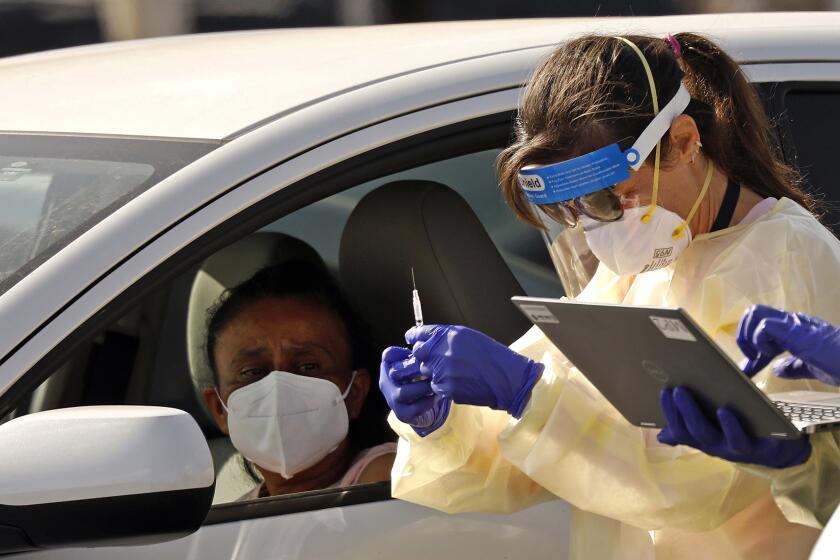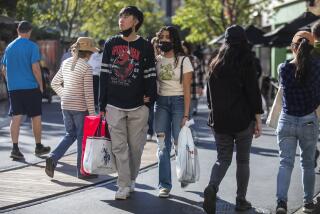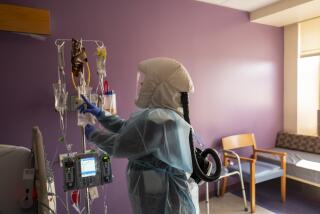Percentage of hospitalized COVID-19 patients dying in L.A. County doubles

The percentage of hospitalized COVID-19 patients in L.A. County who have died has doubled in recent months.
That’s according to an analysis released Wednesday by the county’s Department of Health Services, which found that the share of people who died of the disease while hospitalized increased from about 1 in 8 people in September and October to roughly 1 in 4 since early November.
The increased percentage of deaths coincide with a devastating spike in L.A. County’s death toll. In early November, when the current coronavirus surge began, there were fewer than 20 COVID-19 deaths per day, on average. But over the weeklong period that ended Wednesday, there were roughly 206 deaths reported each day, according to data compiled by The Times.
Despite signs that COVID-19 may be receding, a top Los Angeles County official warned the situation remains precarious.
More than 4,000 of L.A. County’s 14,000-plus COVID-19 deaths have been reported since New Year’s Day. The county accounts for roughly 41% of California’s 35,000 cumulative COVID-19 deaths, despite being home to only a quarter of the state’s population.
Dr. Roger Lewis, director of COVID-19 hospital demand modeling for the L.A. County Department of Health Services, said the increased percentage of deaths is a result of hospitals being so crowded that only the sickest patients are being admitted.
Because hospitalized COVID-19 patients are now uniformly more severely ill, a greater percentage of them are dying.
“During the current surge, while hospitals are critically overcrowded … clinicians are being extremely judicious in their decisions to hospitalize patients,” Lewis said.
“The current data suggests that only patients who are quite ill and clearly require acute hospitalization are being admitted. And it is likely that a greater fraction of patients are being sent home with instructions to return to the hospital should their illness worsen,” Lewis said.
While state data show 7,073 coronavirus-positive patients were hospitalized countywide Wednesday — down more than 12% from the record high of 8,098 set Jan. 5 — the number of COVID patients requiring intensive care has remained relatively flat over that same period, falling to 1,687 on Wednesday, down 2.5% from the high of 1,731 set Jan. 8.
When hospitals are less in crisis, they are more likely to admit people who are on the tipping point of needing hospitalization.
But as demand for resources and beds has grown, so have the needs of COVID-19 patients being admitted in L.A. County.
Here’s a rundown of how the makeup of COVID-19 patients hospitalized in the county has changed from September and October, when the pandemic was less overwhelming, to the surge period that began in November.
Between Sept. 4 and Nov. 3, the resources required on average for each COVID-19 patient were:
• Days in the hospital: 6.93
• Days in the intensive care unit: 2.09
• Days on mechanical ventilation: 1.16
Since Nov. 3, the resources required on average for each COVID-19 patient were:
• Days in the hospital: 9.49
• Days in the ICU: 2.38
• Days on mechanical ventilation: 1.89
The actual care a particular patient needs can vary widely. For instance, some patients may require no care in the ICU, while others may spend weeks on ventilators, struggling to breathe and generally sedated, with a tube inserted through their mouth into the trachea and hooked to a machine that breathes for them.
Though the county has seen some improvement in its overall hospital numbers, Public Health Director Barbara Ferrer stressed that the current figure remains distressingly — and unsustainably — high.
“This is still a very large number of COVID patients, and our hospitals are inundated with people suffering from serious health problems because of COVID-19,” she said during a briefing Wednesday.
Daily deaths remain extraordinarily high in L.A. County, which has resulted in the National Guard being called in to help overloaded hospital morgues by taking bodies to the county coroner’s office for storage until funeral homes and mortuaries can process the backlog. Local air quality officials have suspended monthly limits on the number of cremations to avoid a public health crisis.
The current death rate is “more than double that of pre-pandemic years, leading to hospitals, funeral homes and crematoriums exceeding capacity, without the ability to process the backlog,” the South Coast Air Quality Management District said Sunday.
The air quality agency said that as of Friday, more than 2,700 bodies were being stored at hospitals and coroner’s offices.
In mid-April, when the pandemic was in its early stages, L.A. County’s daily COVID-19 death toll was roughly 50, on average. The current wave has been markedly worse, with the average daily death toll peaking at 241 deaths a day for the seven-day period that ended on Jan. 14.
While the number of daily deaths has dipped, the rate is still significantly higher than at any time in the pandemic. On Wednesday, local health jurisdictions in L.A. County reported 294 COVID-19 deaths, one of the highest single-day tallies of the entire pandemic. The record number of deaths reported in a single day is 318, which was reported on both Jan. 8 and Jan. 12.
“COVID-19 continues to take far too many lives — young and old — and so many families and friends are facing difficult times without their loved ones,” Ferrer said.
Gov. Gavin Newsom said 1 million additional doses of COVID-19 vaccine would be administered in California over the course of 10 days. But due to the state’s data collection issues, it is unclear whether he met that goal.
L.A. County, by far the nation’s most populous, both drives and reflects wider trends happening statewide.
California as a whole has also seen dips in its hospitalization numbers — cause for cautious optimism, officials say, but not celebration yet.
On Wednesday, the number of COVID-19 patients hospitalized statewide dropped to 19,537, the lowest level since Dec. 26. Of those, 4,670 patients are in ICUs, the fewest in two weeks.
“These are rays of hope shining through,” Dr. Mark Ghaly, California’s health and human services secretary, said this week.
But the state, like L.A. County, is seeing high numbers of deaths day over day. California has averaged 485 daily deaths over the last week, an increase of 27% from two weeks ago, according to data compiled by The Times.
Over the last 14 days, California has reported 17.7 COVID-19 deaths per 100,000 residents, the 12th-highest rate among all states, Times data show. Arizona has recorded the highest rate during that time, 28.1.
At Dodger Stadium, the largest of five city-run vaccination sites in Los Angeles, healthcare workers administered 7,730 vaccines Wednesday and threw none out, Mayor Eric Garcetti said. He acknowledged the slow pace at which the vaccines were distributed, with some people waiting up to five hours Wednesday, but he said that the average wait Thursday was 30 to 40 minutes.
He estimated that healthcare workers would inoculate more than 8,000 people at the stadium Thursday.
Garcetti promised to keep trying to streamline the vaccine’s distribution, likening getting an inoculation center as large as Dodger Stadium up and running to “driving a car at 60 mph while building it.”
As the city and county continue to distribute vaccines to growing numbers of people, Garcetti said, he will push for people from communities disproportionately hard hit by the virus — low-income areas where many of the city’s essential workers live — to be “at the front of the line.”
Times staff writers Laura J. Nelson and Matthew Ormseth contributed to this report.
More to Read
Start your day right
Sign up for Essential California for news, features and recommendations from the L.A. Times and beyond in your inbox six days a week.
You may occasionally receive promotional content from the Los Angeles Times.










